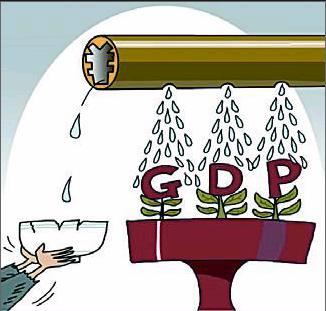Persevering Against Poverty
2014-03-11ByLiLi
By+Li+Li

China is about to overhaul its poverty al
leviation work by reforming a 28-year-old
system that targets counties with a large impoverished population to ensure that government funds will be accurately channeled to those in need.
The Central Government plans to cut the number of counties eligible for state poverty relief, according to announcements made by Wang Guoliang, Deputy Director of the State Council Leading Group Office for Poverty Alleviation and Development, at a press conference in Beijing on January 27.
China introduced a system that identifies underdeveloped counties and flags them as key areas for poverty alleviation work in 1986. After the systems introduction, 331 counties were immediately listed. The list was updated three times, in 1994, 2001 and 2011, and there are still 592 counties that receive relief and preferential policies from the Central Government.
New standard
Currently, aside from earmarking each county on the national list of key areas for poverty al- leviation annual assistance funds of 30 million yuan ($4.9 million) to 50 million yuan ($8.2 million), the Central Government also arranges other grant programs for these counties as well as incentive policies. Each of these poor counties has also been matched with a well-off county in eastern areas under a pairing-up assistance program.
Wang said that with continued economic growth and the establishment of a well-off society in China, the list will eventually be abolished and that his office is exploring the possibility of introducing a scheme to gradually shrink the list.
Anonymous officials from Lanxi County and Hailun City in northeastern Heilongjiang Province, both national key areas for poverty alleviation, recently told Xinhua News Agency that local governments would do whatever they can to prevent their regions from being delisted as it meant losing earmarked funds from the Central Government. Xinhua reported that many local governments of poverty-stricken counties channeled poverty-relief funds to support other operations that can stimulate local economic growth instead of funding poverty alleviation programs.
In an interview, Liu Yongfu, Director of the State Council Leading Group Office for Poverty Alleviation and Development, said that officials in poor counties are evaluated solely on the local economic growth while their performance regarding poverty alleviation is not treated seriously. “As a result, while the economic scale of some counties has been growing vigorously, some of the local people cannot benefit from it.”endprint
On January 25, the State Council, Chinas cabinet, issued a plan for this years poverty alleviation drive in the countryside. According to the document, the major performance gauge for government leaders in key poverty-stricken counties will switch from local GDP growth to the improvement in poor peoples living standards and how much they have reduced the number of people in poverty.
The change of the evaluation standards for officials will guide them to focus their work on lifting people out of poverty instead of pursuing economic development at all costs, said Wang Sangui, a professor at the School of Agricultural Economics and Rural Development of the Beijing-based Renmin University of China.
Greater transparency
While explaining the State Councils poverty alleviation plan, Wang Guoliang pointed out problems that hinder the current initiatives.
“For a long time, our poverty relief efforts have not been well targeted, which resulted in misuse of government funds and incentives,”Wang Guoliang said.
In December 2013, the National Audit Office (NAO) said that some funds set aside for underdeveloped regions had been misused based on an audit carried out across 19 targeted counties in six provincial-level regions of Guangxi, Yunnan, Guizhou, Shaanxi, Gansu and Ningxia in April and May of that year. It audited funds appropriated to these counties from 2010 to 2012.
During the three years, 3.92 billion yuan($643 million) was injected into the 19 counties with the audit checking 32 percent of it, or 1.24 billion yuan ($203 million).
The audit found that 326 million yuan ($53 million) had been misused through false declaration, embezzlement and officials wasting it on expensive gifts, banquets and tours. The results led to a total of 137 individuals being investigated, Jiang Xiaohua, an official with the NAO, revealed.
According to the State Councils plan, county-level governments will be charged with identifying all of the poor population under their jurisdiction by visiting potential households and then publicizing the information gathered so as to prevent fraud. Moreover, an active national database of poor households will be established, where the financial information of each will be updated routinely.
Li Jing, a senior research fellow with the Rural Development Institute of the Chinese Academy of Social Sciences, said that whether or not households were entitled to government poverty relief grants used to be decided on by a village or township official, which left higherlevel governments unable to discover fraud. As a result, households with close links to officials had access to grants when they didnt need them while those in need were denied access to these grants.endprint
“In recent years, some villages adopted the voting system to decide on the list of potential grant recipients and publicized their information. This reform won a lot of support and praise and should be further promoted,” Li said.
Wang Guoliang said that the procedure of identifying the cause of poverty of each listed household and giving them the help they need is key to the success of poverty relief efforts.
“For example, for those households whose income earners cannot work due to illness or injury, it is necessary to distribute more social security benefits to them. For families that became poor after paying enormous medical bills for a family member, it is important to find jobs or entrepreneurship opportunities for them. A large amount of detailed investigative work is needed to ensure that different households are given tailored grant programs or incentives,”Wang said.
Each household will be assigned a government official to help it to climb out of poverty, said the State Councils plan.
The new plan is also targeted at reforming the distribution of government poverty alleviation funds. According to the plan, the power to ratify programs using these funds will be delegated to county-level governments while provincial- and city-level governments will be primarily responsible for supervising the use of these funds.
Wang said that provincial governments, which now possess the power to ratify most poverty alleviation programs, cannot learn the actual situations of each village, while county or township governments can better manage these programs, which are mostly small in scale. He believes that the latest reform can raise the efficiency of government funds.
Li said that the design and implementation of the governments poverty relief programs should also take advantage of market mechanisms and non-governmental organizations. She said that government projects can cooperate with similar projects funded by enterprises or other private investors so that the participation of private capital can be maximized. “The use and supervision of government poverty alleviation funds could be entrusted with a third party, such as NGOs or even the villagers benefiting from these programs,” he suggested. n
Better Off
Since the initiation of reform and opening-up policies in the late 1970s, the Chinese Government has implemented extensive poverty alleviation efforts with the aim to secure subsistence, especially food and clothing, for poor rural residents. By the end of 2010, it had managed to reduce the impoverished rural population, who lacked food and clothing, from 250 million to 26.88 million, which in turn lowered the percentage of rural residents in poverty from 30.7 percent to 2.8 percent, according to a paper released by the Chinese Academy of Social Sciences.
China has made outstanding con- tributions to global poverty alleviation efforts, accounting for 76.88 percent of the total reduction in the number of people living in poverty globally between 1990 and 2005, according to statistics from the UN Development Program.
Rural residents with an annual percapita net income of 2,300 yuan ($377) or less are classified as poor under Chinas national poverty standard adopted in 2011, an increase from the 1,274-yuan ($209) standard used before the change.
Based on the latest national poverty line, Chinas poor population in rural areas declined from 122.38 million to 98.99 million throughout 2012, down by a remarkable 8 percent.
(Compiled by Beijing Review)endprint
